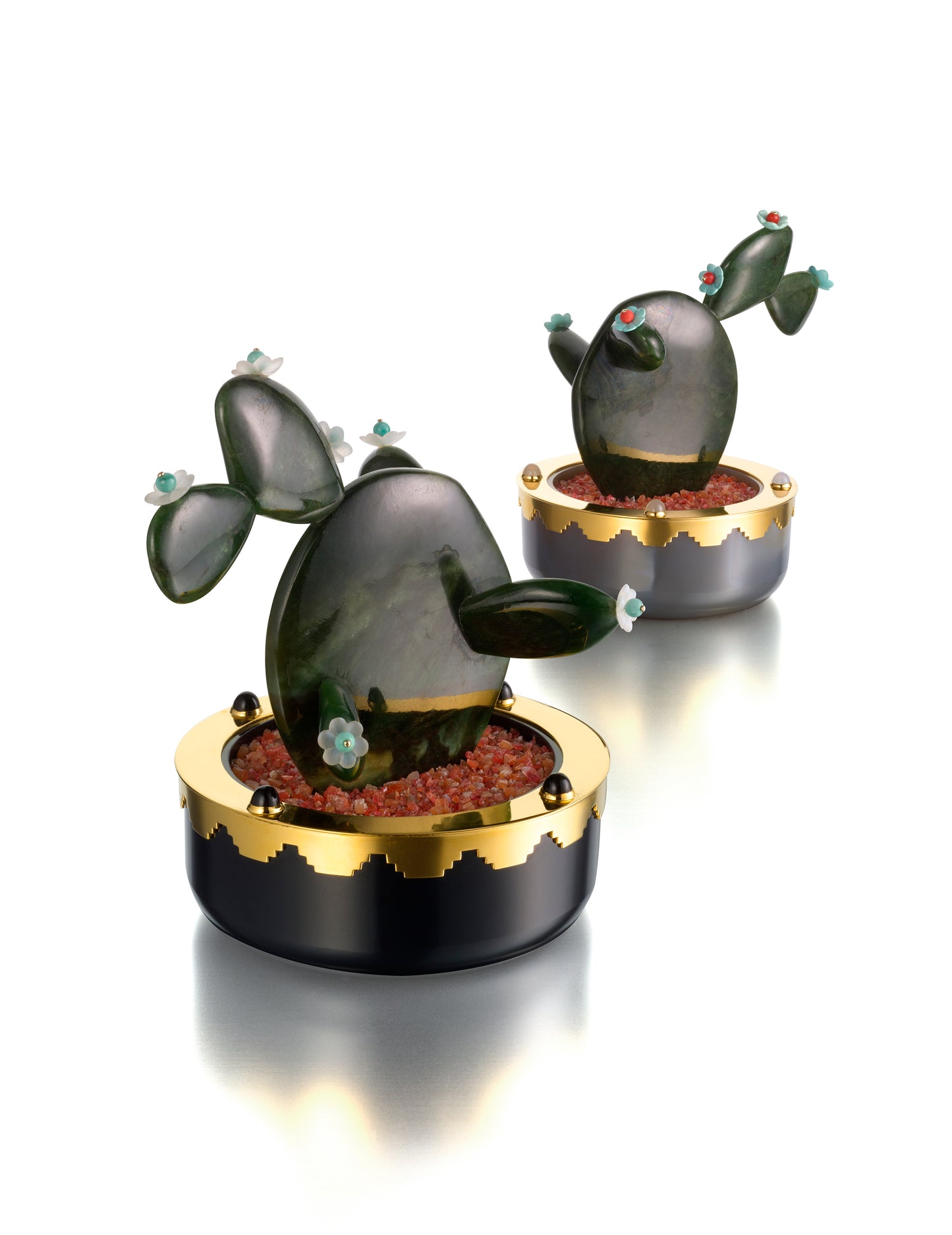PAIR OF ART DECO SILVER GILT, SIBERIAN NEPHRITE, AGATE, ONYX, AND MULTI GEMSTONE FLOWERING CACTI BY CARTIER, PARIS, CIRCA 1925
PAIR OF ART DECO SILVER GILT, SIBERIAN NEPHRITE, AGATE, ONYX, AND MULTI GEMSTONE FLOWERING CACTI BY CARTIER, PARIS, CIRCA 1925
SOLD
A pair of Siberian nephrite cacti, one set in a round grey agate pot and the other in a black onyx pot, the silver-gilt rims enhanced with a cut ziggurat border with four cabochon stones, one with black onyx and the other with moonstones; each pot filled with aventurine quartz; both cacti with flowers, one in turquoise with coral centers and the other with moonstone and turquoise centers; in original fitted boxes
- Stamped Cartier Made in France, on metal surround; boxes with Cartier New York
- Measurements: 6 11/16 × 5 1/16 inches and 5 1/2 × 5 1/2 inches
Additional cataloguing
Provenance
- George and Frayda Lindemann
Literature
- Fane, Harry, Hans Nadelhoffer, Eric Nussbaum, John W. Keefe, and Darrell Lee Brown. Reflections of Elegance: Cartier Jewels from the Lindemann Collection. New Orleans: New Orleans Museum of Art, 1988, p. 113.
Exhibition
- Reflections of Elegance: Cartier Jewels from the Lindemann Collection, New Orleans Museum of Art, Louisiana, November 1988–February 1989
Biography
Cartier was founded in Paris in 1847 by Louis-François Cartier. His three grandsons, Louis, Pierre, and Jacques, built the house into a famous international jewelry empire serving royalty, Hollywood stars, and socialites. Cartier has created some of the most important jewelry and objects of art of the twentieth century with many iconic designs such as mystery clocks, Tutti Frutti jewelry and the Panthère line. In 1983, The Cartier Collection was established with the objective of acquiring important pieces that trace the firm’s artistic evolution. Today, Cartier has 200 stores in 125 countries.
Significance
During the first decade of the twentieth century, Cartier was inspired by Fabergé to create luxury objects in the Russian style. Card cases, powder boxes, desk sets, cigarette cases, and paper knives were just a few of the items, but the most fanciful were sculpted animals and beautiful flowers in glass cases. In 1916, Vogue wrote of “Cartier’s dainty hothouses in which fairy-tale trees with gold and silver trunks sprout leaves of jade.” J. P. Morgan, Lady de Grey, and King Alfonso XIII of Spain were all collectors. The most inventive example depicts a succulent rather than the typical flower and breaks out of the freestanding case.
For this object, Cartier created an Opuntia, or prickly pear cactus, native to North America. It was an unusual departure for an art form so steeped in Russian history that the workshop of Aristide Fourrier, who created the hardstone flowers to Cartier’s designs, specifically purchased Russian materials (such as Siberian nephrite) from Idar-Oberstein in Germany. Louis Cartier had on of the best private libraries in Paris filled with eighteenth-century miniatures and botanicals that he and his designers turned to for inspiration. Also, in 1910 a greenhouse of cacti opened at the Jardin des Plantes des Paris, providing an opportunity to study Opuntia in person. Cartier recreated this cactus in the Art Deco style, focusing on the strong oval geometry of the cladodes (paddle-shaped leaf-like stems) and embellishing the pots with ziggurat borders, a motif he favored. The combination of deep green and red with touches of blue creates an object with strong presence. The difference in color between the grey agate and black onyx is a subtle move highlighting the striations in the nephrite, and the flowers of each cactus bloom in different colors, highlighting the variations in nature.
Only Cartier would have created such a beautiful, yet whimsical sculpture. These pieces are a testament to the creativity that has been a hallmark of this house. They were owned by George and Freyda Lindemann, discerning collectors known for choosing some of the best examples of Cartier. Beautifully constructed with a strong sense of composition, these exquisite cacti would be a rare and important addition to any collection.







